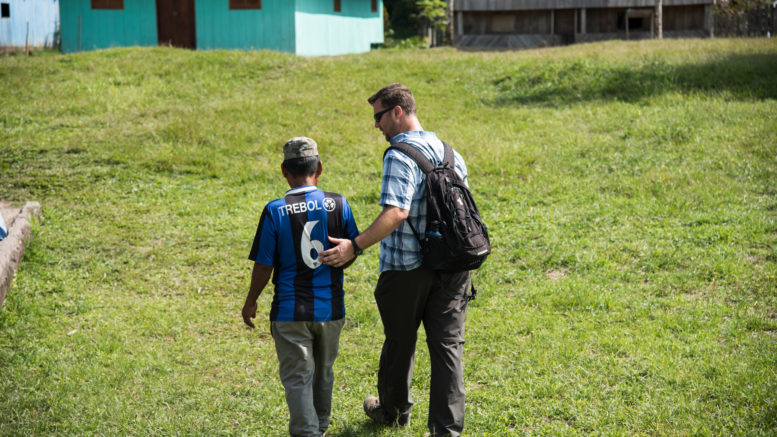Theogony editors Griffin Harris and Sam Wingfield write from the Peruvian Amazon about their experience with a local indigenous tribe and its unlikely friendship with a George Mason University professor.
SUCUSARI RIVER BASIN, PERU–In contrast to the 20 foot high sign he stands under, Sebastián Ríos Ochoa exists low to the ground. The jungle–the same jungle that the sign above boasts in map form–looms in the background. From a distance, Ochoa’s stature is clear: strong and stout, with broad shoulders formed by a lifetime of paddling. Clad not in the traditional loincloth of his ancestors, but in a worn Peruvian fútbol tee and long-hanging shorts, Ochoa presents himself proudly–if not stereotypically.
As the boat, a slow-moving motorized skiff, eases forward, Ochoa’s face comes into focus as well. It is appropriate, perched on a body equipped for the perils of the forest. Ochoa is a proud recorder of those perils, most strikingly in the form of a curling scar that descends from his lower lip. It shows that his relationship with the jungle is reciprocal in the two obvious ways, sustenance and culture, but also in a third: respect. No other local person, nor any of the scientists who frequent this part of the Amazon basin, embodies this respect more fully than Ochoa.
He is the leader of the Maijuna, an indigenous tribe whose largest village is a few hours’ boat trip from the city of Iquitos, Peru. Separated into four small villages, this tribe, like many other native tribes in the world, is in a fight for its survival. This fight–la lucha, in Maijuna parlance–has often been fought uphill, Ochoa says. “Our culture has, in many ways, been degraded over time. Nowadays, we don’t do many of the traditional ceremonies or dances that used to be very important to us.”*
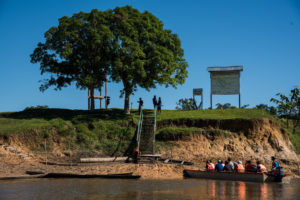
Steps leading to the Maijuna village of Sucusari, as seen from the Sucusari River. (Photo: Brian Griffiths)
By this time, our group of George Mason University students in a field course, “Conservation and Sustainability of the Amazon,” has reached the map where Ochoa waited for us. He is now busy embracing his longtime friend, George Mason professor Michael Gilmore. Side by side, they are an odd sight–Gilmore dwarfing his counterpart in size but equaling him in joviality.
A short time later in the maloca, the communal gathering place sheltered by a high, peaked roof woven from palm leaves, Ochoa greets his visitors. Our similarities to the European peoples who, since the 17th century, have threatened Ochoa’s people notwithstanding, he is hospitable and friendly. “Good morning and thank you all for coming,” he begins, with Gilmore translating. The professor learned his Spanish from the Maijuna, who themselves speak a fluid version of the language; somehow, Gilmore manages to speak Spanish with his native New Jersey accent. “I am very proud to be able to give you all a tour of my home.”
Gilmore explains to the class that the same geniality and warmth was extended towards him 18 years ago, when as a PhD student he first went to Maijuna lands. His role with the community, though, has since evolved.“The [PhD] research was more theoretical in nature,” he says, “and since then I’ve transitioned to more applied, community-based work that can make a difference and help the Maijuna beat the conservation and sustainability challenges that they face as a people.”
Gilmore’s professional development is somewhat unconventional. As he realized that the Maijuna’s land and culture were in danger, he learned to combine research with advocacy to help the Maijuna preserve their traditional way of life and the land that supports it. He yields the floor to Ochoa, however, so that the narrator of Maijuna lore can tell of his people’s past.
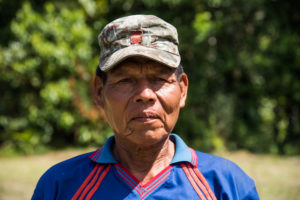
Sebastián Ochoa, leader of the Maijuna. (Photo: Brian Griffiths)
***
The largest Maijuna village here is about the size of three city blocks. The homes have similar structures: wooden stilts, about five feet high, support a few connected open-air rooms while thatch roofing from palm trees provides cover from the heavy sun and frequent downpours typical of this tropical rainforest. Every house has a kitchen, where an earthen fireplace is used to cook, a bedroom, and a common room. Despite the uniformity of architecture here, the colors are diverse: pink- and blue-painted buildings dot the community, while palm fiber hammocks, brightly dyed by the berries which make up the Amazonian painter’s palate, swing on porch decks. There are about 30 houses in this village, along with a handful of other community buildings and a couple of pit latrines. To residents of the metropolitan D.C. area, this community seems small; but to Ochoa, this is a large, connected village, a departure from the traditional ways of Maijuna life.
“Originally, we did not live this far down the [Sucusari] river, like we do now,” Ochoa says. “We lived much deeper in the forest, near the headwaters of the Sucusari, and in isolated family groups. Now that our way of life has changed, now that we have schools for our children, we must live in a more accessible place.”
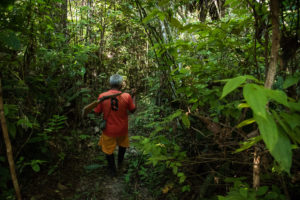
Victorino Rios Torres, a Maijuna hunter, walks through the jungle. (Photo: Brian Griffiths)
Change is not new for the Maijuna. Since Europeans arrived in the Amazon basin, the Maijuna have faced pressures that threatened their culture and, at times, their very existence. In the 1700s, Franciscan and Jesuit missionaries settled in the area, marking the start of a dangerous trend of subjugation by outsiders. Next came rubber barons, who, without protest from the newly minted Peruvian government, enslaved the Maijuna. It was more than a century later, in the 1900s, when Peru officially recognized Ochoa’s tribe as an indigenous people.
However, there were still active, although less malevolent, threats to the Maijuna culture after 1950. Protestant missionaries were given access to the Maijuna lands in 1955, and because of them Christianity and Spanish began to replace the traditional religious beliefs and language used.
Ochoa, 62, says that Maijuna life was very different before the missionaries’ influence took hold. “Our life was more traditional. There were more animals to be hunted; we knew the forest better and used it more; we spoke the traditional Maijuna language more.”
Less than three years removed from Gilmore’s first stint of dissertation work in the Sucusari village, a fresh threat from outside arrived. It came in the form of logging. “Our grandparents who took care of things left us all of this [timber],” Ochoa said once to Gilmore. “But, unfortunately, we didn’t know how to value what they left us and we let other people in to destroy it. It saddens me that we didn’t think this could happen. We didn’t think about our children. We didn’t think about our grandchildren.”
The forest, which bears an inextricable link to the Maijuna, was pillaged by loggers–forcing famine on the community. No longer were there plentiful tapirs, pacas and peccaries to be hunted. Fish, the leading source of protein for the Maijuna, were indiscriminately killed with poison and their numbers plummeted.
Ochoa says that, to many of the tribe’s elders, this felt like more of the same maltreatment and disdain to which the Maijuna had been subjected for centuries. “We have always been viewed as outsiders, not as citizens of Peru or even as our own people. It has been difficult to achieve just the level of recognition we have now.”
Ochoa explains that because indigenous groups are thought of as lesser than other Peruvians, outsiders feel allowed to exploit them and their ancestral land. His voice grows husky as he shares a story of oppression on the streets of Iquitos–and Gilmore, a catch in his throat, remarks, “this is a powerful moment,” before translating. The injustice is profound and personal, clearly.
“Because of the racism that I felt throughout my life, speaking Máíhikì [the native language of the Maijuna] in the city would cause people to look down on me, like I was worthless. Because of this, I was losing my language; the language of my people. But now I recognize my freedom to speak my language, and I am no longer afraid. I should not be embarrassed of my heritage.”
The Máíhikì language is an especially crucial part of the native culture that is endangered, Ochoa warns: “When I was growing up, my brother became the first bilingual school teacher, and so I learned Spanish and Máíhikì…Now in a village of about 150 people, I am one of only 18 who can speak and understand Máíhikì–and the only one who can read and write in it.”
Gilmore explains that, because the only school in the Maijuna village today is run by the Peruvian government, Máíhikì is not a valued part of the curriculum. “None of the children learn it,” Ochoa says. “They all learn Spanish from the teachers, who, even though many are native Maijuna, do not know the language themselves… I have tried to work in the school to teach the language to the children so that it can live on in Maijuna culture, but the government does not allow it because they fund the school and don’t view Máíhikì as essential knowledge for Peruvians…But most of the people who speak the language are the Maijuna elders, and if the children don’t learn it, Máíhikì will die in one or two generations.”
Today, the loggers forced out and the language at a tipping point, the Maijuna still grasp their most tenable feature: sense of belonging. Unlike the flag-waving patriotism often seen in the United States, the Maijuna show their pride with unwavering authenticity. Ask any community member what it means to be Maijuna, as we did, and you’ll get nearly identical answers: “It means everything.”
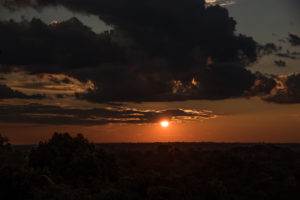
Amazonian sunset as seen inland of the Sucusari River. (Photo: Brian Griffiths)
***
Working together, the Maijuna and Gilmore established an indigenous federation, FECONAMAI, in 2004, which created an official Maijuna entity. Ochoa is the president.
More than a decade later, in 2015, the Maijuna-Kichwa Regional Conservation Area, a near-million acre parcel of primary rainforest and Maijuna ancestral land, was created through this centralization of Maijuna voices and aid from Gilmore. It is a source of pride for both the professor and the Maijuna; Gilmore calls it a strong step forward in the preservation of Maijuna culture.
He recently co-founded the non-governmental organization OnePlanet, a self-described partner of indigenous communities that works with groups rather than for them. OnePlanet has done several projects with the Maijuna that focus on cultural and environmental sustainability.
Before OnePlanet’s work, for instance, the Maijuna would cut down entire adult Aguaje palm trees to harvest the fruit at the top. The practice was unsustainable: many wildlife species that relied on the trees’ fruits declined, the rainforest was further degraded, and Maijuna did not regularly have the fruits that are a staple of their diet and an important source of revenue. With help from OnePlanet, the Maijuna employed a harnessed climbing system that, attached to the climber’s waist and upper thigh, wraps around the trunk of the tree to allow its user to pull himself up to the height of the fruits. Even this solution should only be temporary, OnePlanet says. The goal of their Aguaje Palm Project is to have the Maijuna grow these trees in their own agricultural fields, thus eliminating the need to harvest from the wild.
Telmo Sangama, a Maijuna grower, has embraced OnePlanet’s agricultural efforts. Sangama, in addition to the Aguaje palms that he grows, has, by his own estimates, 5,000 domesticated cacao trees that vary in size and production; the mature trees produce near 40 fruits each harvest. This tree produces the fruit from which chocolate comes, but even the flesh hugging the raw seeds makes a succulent treat that the Maijuna enjoy. Sangama, though, is more interested in their appeal to buyers in Iquitos. He sells his cacao seeds there–along with the honey he harvests from his stingless bee hives, another OnePlanet project–to sustainably support his family.
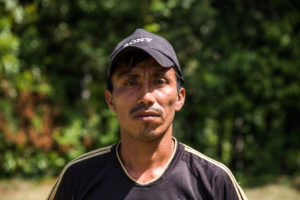
Telmo Sangama, Maijuna grower. (Photo: Brian Griffiths)
To Gilmore, though, who has a special emotional connection to the Maijuna, the most important of the OnePlanet work is their Clean Water project.
While visiting the village, we get the chance to see the water project working in a Maijuna home. Laurence Benson, who designed the biosand water filter while still a student in George Mason’s engineering school, explains how, using only rocks, sand from the river, and gravity, repurposed plastic drums can make disease-ridden water from the Sucusari into clean drinking water in minutes. Benson’s water filters, which cost a mere $30 per unit and are easy to repair, are now in over 75 Maijuna households. Benson and OnePlanet have targeted the sanitation problems that plague developing nations, particularly in Latin America, by running hygiene workshops and teaching Maijuna families how to install and repair the water filters.
After Benson describes the engineering specifics of the project, Gilmore rises from the audience to describe its significance. “Before the Maijuna had these water filters, children would die from dysentery and other water-borne illnesses.” His usual enthused and playful voice, which fits perfectly the professor’s burly frame and relentless smile, drops an octave. “I know people here, since I started working here, who have lost children–infants. You know, I have a two-year-old at home and to think of something like that happening to her, just because she didn’t have clean drinking water.” His voice wavers more and tears well in his eyes as he struggles to finish his sentence. “It’s just hard to think about.”
***
Our group’s final visit with the Maijuna ends in the same way the first visit began. The Maijuna, challenging the ubiquitous American assumption that the developing world is dangerous and unfriendly, thank us profusely. They say what a pleasure it was to show their village and their life to students, and extend an invitation to return. Ochoa’s best friend, Victorino Rios Torres, walks our group back to our point of entry–a set of weathered wooden steps that ascend the murky river bank to the elevated, grassy plain atop which the community rests. Lagging behind are Gilmore and Ochoa, exchanging good-byes until next time–which, Gilmore predicts, will be this winter. Gilmore is always smiling; his laughter, which fills the entire village, makes him seem more like a friend than a high-ranking academic. But Ochoa, whose face is that of a solemn, worn man, smiles cheerfully as he and Gilmore embrace.
Gilmore is sustained by his deep and longstanding relationship with the Maijuna, particularly Ochoa. “He has enriched my life,” Gilmore says of Ochoa. “I consider him one of my closest friends in the world.”**
*Quotes are translated from Spanish and thus, while accurate accounts of what was said in interviews, are not verbatim.
**A special thanks to Michael Gilmore for his insight and use of the documentary film, Guardians of the Forest, which he co-produced. Many thanks are also due to the Maijuna, for their hospitality and time.

